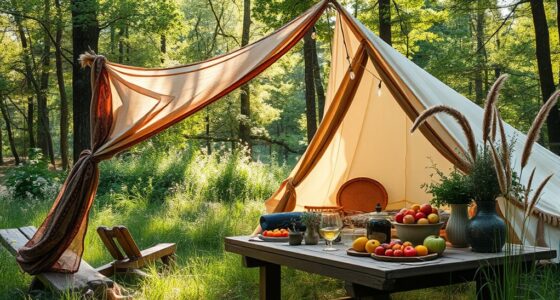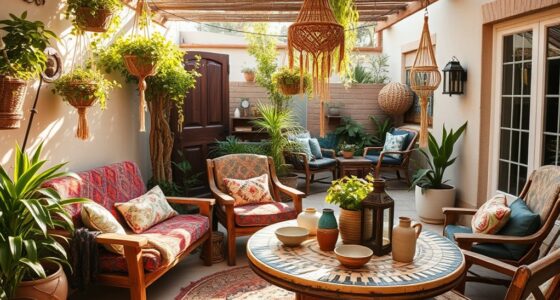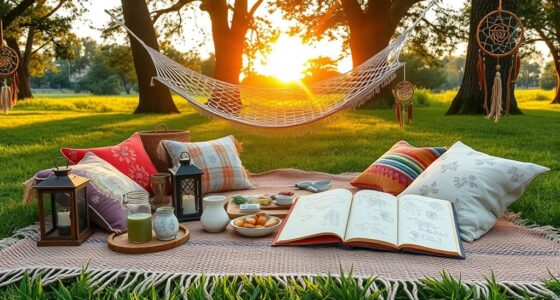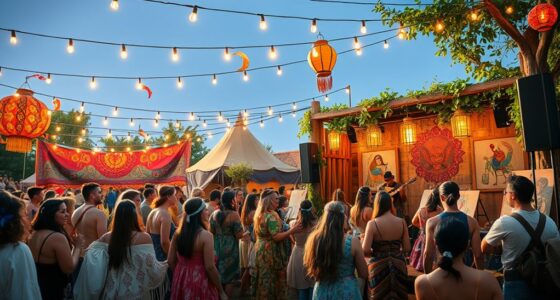Embracing slow living with boho principles helps you simplify your life, prioritize mindfulness, and enjoy each moment fully. Focus on slowing down intentionally, creating routines that anchor you, and connecting deeply with nature. Practices like mindful rituals and relaxing outdoor activities reduce stress and boost your well-being. By living authentically and appreciating small details, you’ll cultivate joy and balance. Keep exploring to discover how these gentle shifts can lead to a more stress-free, fulfilled life.
Key Takeaways
- Embrace mindful routines that prioritize presence and intentionality over speed, creating a relaxed, stress-free lifestyle.
- Incorporate outdoor activities and connection with nature to foster calmness, sensory engagement, and balance.
- Cultivate a boho-inspired, free-spirited mindset that values simplicity, authenticity, and living in harmony with oneself.
- Use routines like meditation and leisurely walks to ground yourself, reduce stress, and deepen your appreciation for everyday moments.
- Focus on living authentically by slowing down, paying attention to small details, and embracing the beauty of a relaxed, mindful life.
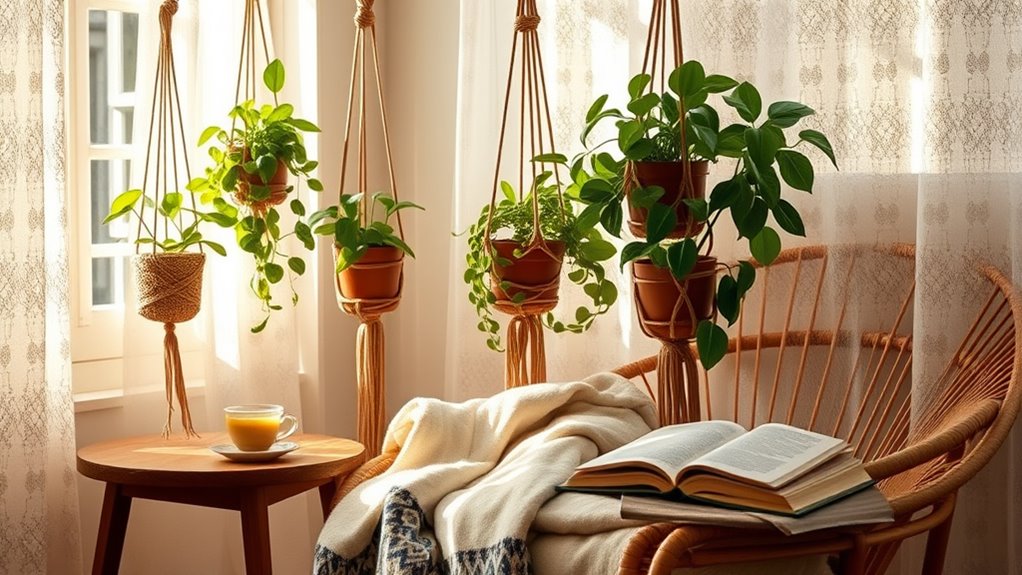
In a fast-paced world that often values speed over sustainability, embracing slow living principles offers a revitalizing alternative. You begin to realize that slowing down isn’t about doing everything at a snail’s pace but about intentionally choosing how you spend your time. One of the core aspects of this approach is cultivating mindful routines. Instead of rushing through your day on autopilot, you start to pay closer attention to each moment. Whether you’re preparing a meal, working, or relaxing, you focus fully on what’s happening right now. This mindfulness helps you appreciate the small details—like the aroma of your coffee or the feel of a soft blanket—turning ordinary activities into meaningful experiences. Over time, these routines become anchors that ground you, reducing stress and increasing your sense of fulfillment.
Another essential element of slow living is deepening your connection to nature. You might set aside time daily or weekly to step outside and immerse yourself in the natural world. It could be a walk in the park, tending to a garden, or simply sitting quietly under a tree. This connection isn’t just about physical proximity but about engaging your senses and being present in the environment around you. Nature has a calming effect that counteracts the chaos of modern life, helping you reset mentally and emotionally. When you slow down to notice the rustling leaves, the chirping birds, or the way sunlight filters through branches, you cultivate a sense of harmony and balance. These moments remind you that life isn’t a race but a journey to be savored. Recognizing how dreams can serve as a spiritual connection can deepen your appreciation for the quiet messages from your subconscious.
Incorporating mindful routines and strengthening your nature connection often go hand in hand. For example, you might start your mornings with a few minutes of silent meditation outdoors or take a leisurely walk after dinner. These practices not only foster a sense of calm but also reinforce your commitment to living intentionally. Slow living isn’t about abandoning productivity; it’s about aligning your actions with your values, creating space for reflection and genuine connection. As you adopt these principles, you’ll notice a shift in your overall well-being—less stress, more joy, and a renewed appreciation for the simple pleasures that make life meaningful. By intentionally embracing mindful routines and a closer bond with nature, you pave the way for a more balanced, stress-free existence rooted in authenticity and peace.
Frequently Asked Questions
How Can I Start Practicing Slow Living in a Busy Schedule?
To practice slow living in a busy schedule, start by creating mindful routines that prioritize your well-being. Use simple time management techniques like setting boundaries and scheduling moments for rest and reflection. Focus on being present in each activity, even if it’s just for a few minutes. By intentionally slowing down and embracing mindfulness, you’ll find it easier to reduce stress and enjoy a more balanced, fulfilling life despite a hectic pace.
What Are Common Misconceptions About Boho-Inspired Slow Living?
Did you know that many believe boho-inspired slow living means constant relaxation? In reality, it’s about embracing minimalist clutter and spiritual symbolism to create intentional spaces. A common misconception is that you need a boho aesthetic to practice slow living, but it’s more about mindful choices. You can incorporate these principles into any style, fostering peace and balance without sacrificing your personal taste or busy schedule.
How Does Slow Living Impact Mental Health Long-Term?
You might find that slow living boosts your mental health over time by encouraging mindfulness meditation, helping you stay present and reduce stress. As you embrace a calmer pace, you build emotional resilience, making it easier to handle life’s challenges. This long-term practice promotes better mood, clarity, and overall well-being, creating a more balanced mind. With consistent effort, slow living becomes a powerful tool for lasting mental health benefits.
Can Slow Living Principles Be Adapted for Urban Environments?
You might wonder if slow living principles can work in cities, and the answer is yes. Urban adaptation involves incorporating city mindfulness—finding quiet moments amid busy streets and crowded spaces. By intentionally slowing down, prioritizing meaningful activities, and creating calming routines, you can bring the benefits of slow living into city life. It’s about making mindful choices that help you stay grounded despite the hustle and bustle around you.
What Are Budget-Friendly Ways to Incorporate Boho Style Into Daily Life?
To incorporate boho style on a budget, start with DIY decor projects like creating wall hangings or painted planters. Thrift shopping is your best friend—look for unique textiles, vintage furniture, and accessories that add character. Mix and match patterns and textures freely, and don’t forget to layer rugs and cushions. These simple, affordable steps help you embrace boho’s relaxed vibe without overspending.
Conclusion
Embracing slow living isn’t just a trend; it’s backed by research showing reduced stress and improved well-being. When you prioritize mindfulness, simplicity, and connection, you give yourself permission to breathe and enjoy life’s moments. So, next time you feel overwhelmed, remember that slowing down can actually boost your happiness and health. Trust me, slowing your pace might just be the secret to a more peaceful, fulfilling life—proof that less truly is more.



